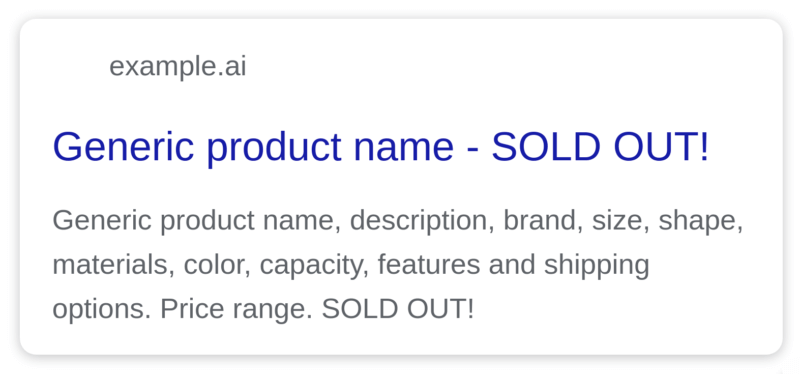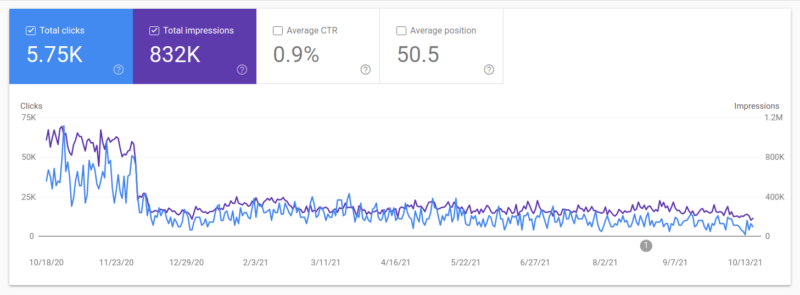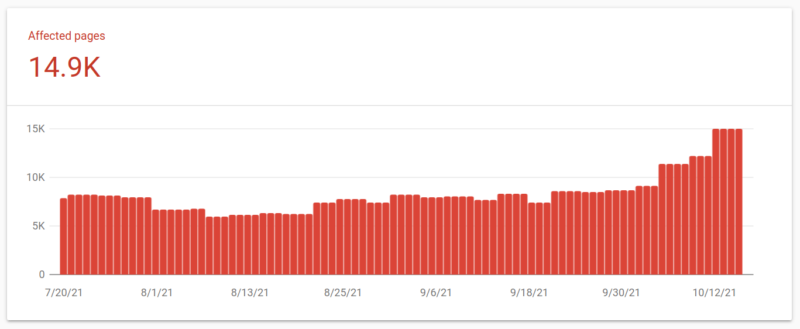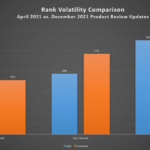How expired landing pages kill your Google rankings

A lot of landing pages expire every day when outdated information becomes obsolete, products are sold out, services are discontinued and entire communities sunset. How that expiring content is being handled from an SEO perspective can greatly impact the organic search rankings of websites. If its handling is floundered, SEO landing pages with expired content have the potential to kill the organic rankings of the website overall.
PageRank vs. user signals
A frequently mentioned argument made by website owners for maintaining landing pages with expired content, especially sold-out products, is to preserve incoming external PageRank to the website. It is a false assumption that a landing page must be maintained as indexable and by returning a 200 OK status code, even when a product or service isn’t available to users any longer in order to keep whatever authority or PageRank that same landing page has accumulated over time. Doing so effectively means creating a soft 404 landing page. A soft 404 is an error page with no relevant content which continuously returns a 200 OK status code instead of a 404 or 410 status code.
For a number of reasons, that strategy is a recipe for disaster. Firstly, the conversion rate rather than presumed PageRank accumulation ought to be the primary goal of a commercial website. After all, no publisher cares for their PageRank value, high or low, as long as conversions meet or exceed expectations. Secondly, PageRank can not be gauged by any degree of accuracy. PageRank changes continuously as Googlebot crawls the web and Google does not disclose the actual value for individual landing pages or websites. No external third-party tool can substitute that value in any meaningful way. Finally, product landing pages rarely attract lasting, high-quality, merit-based backlinks to begin with. Effectively, the perceived PageRank loss is debatable, while actual PageRank loss is negligible.
Soft 404s are bad for user experience and therefore a thorn in the side of search engines, Google in particular. This is why maintaining expired content landing pages, especially unavailable product pages, considerably magnifies the risk of poor user signals. Google has become more adept in identifying negative on-page language and can accurately detect strings like “unavailable,” “out of stock,” “0 results found” or “sold out.” Frequently, yet not always, it will highlight the problem as soft 404 pages in Google Search Console. However, a major issue is that CTR is likely to suffer from snippet representation, highlighting information that services or products are unavailable to the user. Worse yet, if users are still compelled to click on results that turn out to be discontinued landing pages (also known as soft 404s), they are almost inevitably going to return to search results, look for an alternative and/or refine their query. Doing so, the users indicate with their click behavior that the individual user experience was bad for them. With this “bounce rate” growing, which is often mistaken for, yet unrelated to, the Google Analytics or on-site bounce rate, the relevance of the website as a whole suffers in the organic search rankings.
Although PageRank remains an important ranking factor, it pales in comparison with the weight of user signals which search engines collect for rankings. While emphatically denying the use of specific user signals, such as Google Analytics data or dwelling time, Google continues to favor websites that are popular with users. When compared against each other, the PageRank argument does not stand a chance. On the one hand, PageRank remains elusive and at best a means to an end. User signals on the other hand, directly and imminently contribute to the success of a website, with and beyond SEO.
The trends game
Google rankings, to a large extent, depend on SEO signal trends. For a large website, with many millions of relevant landing pages, a few thousand expired content landing pages are unlikely to trigger a ranking loss. They are relatively too few to decidedly tip the trend of a website’s signals one way. For a smaller website comprising ten thousand landing pages in total, a few hundred expired indexable landing pages can already pose an SEO danger.

Ultimately, the decisive factor is trends measured in percentages, rather than the actual total numbers of indexable expired content or soft 404 landing pages. Which website ranks well and which one does not depends on a number of critical factors. These include, among other factors, the total volume of crawlable landing pages, their content quality, the overall trends involved and, most importantly, the user experience signals trends indicating user satisfaction.

There are no fixed thresholds that must be observed. Instead, trends are front and center when SEO signals, and therefore organic search rankings, are to be improved. The question of how well a specific website fares in this regard can only be answered by analyzing the website’s specific data, especially its server logs. This is why commercial websites with a sizable and changing product database must regularly perform technical SEO audits.
In-depth SEO audits are the only means of accurately gauging crawl budget management, or how long it may take for Google to re-crawl expired landing pages in order to register the changes applied. Only an SEO audit can help to identify whether expired content landing pages pose a problem and/or if it’s a serious one.

Doing it the right way
Larger sections of a website that have outlived their usefulness but can’t be deleted, like sunset communities, can be moved off domain, thereby boosting the main website’s trend signal. In that instance, 301 Moved Permanently redirects must be established and maintained without an end date or return 404 status code so search engines know to discount the content.
Expired product landing pages, however, must not be 301 redirected to other landing pages, thereby meddling with user signals. Instead, when products or services are no longer available, respective landing pages must return either 404 Not Found or 410 Gone HTTP status codes. Doing so, these status codes will signify to Google and other search engines that the landing pages no longer provide what they used to and strengthen the user signals of the remaining, still available 200 OK landing pages that continue to offer products or services.
There is, however, a possibility to legitimately capitalize on 404 error pages without taking the unnecessary business risk of confusing search engines or diluting user signals. That is by enhancing 404 Not Found pages, which still return this correct status code and supplementing the content of the error page with relevant, in-context information for users. These so-called smart or custom 404 landing pages must continue to address the fact that their main purpose, product or service is unavailable. But, they can be augmented with relevant product alternatives and/or the results of an internal search based on keywords from the request URL, enabling users to continue on their journey within the website — and for the website operator to potentially still capitalize on the lead. Custom 404 pages are not an SEO growth method, but much rather a means for maintaining user satisfaction and improving conversions. When applied, they pose no SEO risk as long as the status code is still a 404.
Ultimately, whether expired content landing pages return 404, 410 or a custom 404 response, it is important not to block the URLs in the robots.txt. Doing so inhibits search engines from crawling and understanding the changes applied and can have an undesirable effect on user signals.
At the same time, internal linking to expired content landing pages must be updated and consequently discontinued. Internal linking is among the foremost important on-page signals indicating to search engines both relevance and importance from a crawl priority point of view, hence there’s no point in boosting content landing pages that have expired.
Lastly, it is important to always keep in mind that 404 Not Found landing pages, no matter how numerous, will not impact a website’s organic rankings. No website ranks poorer or better because of, or despite, its 404 Not Found pages. Soft 404 landing pages, however, can not only impact rankings but also have the potential to drag down the entire website in organic search.
The post How expired landing pages kill your Google rankings appeared first on Search Engine Land.



